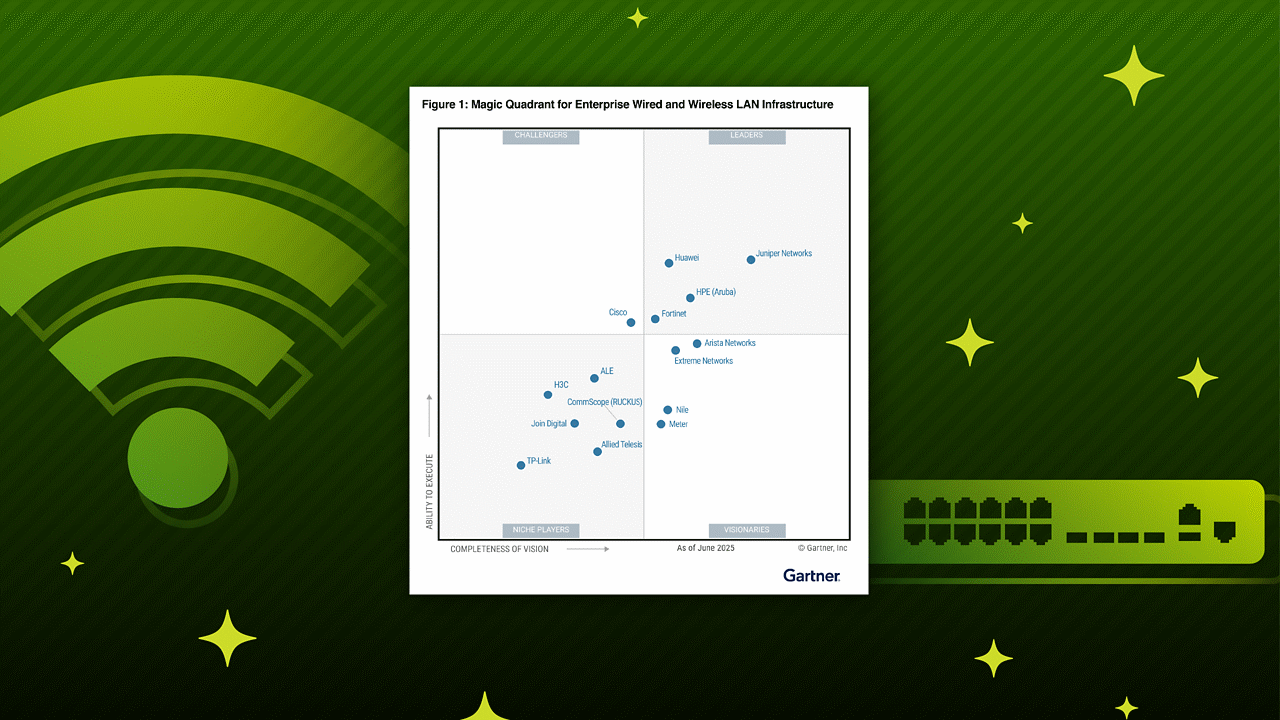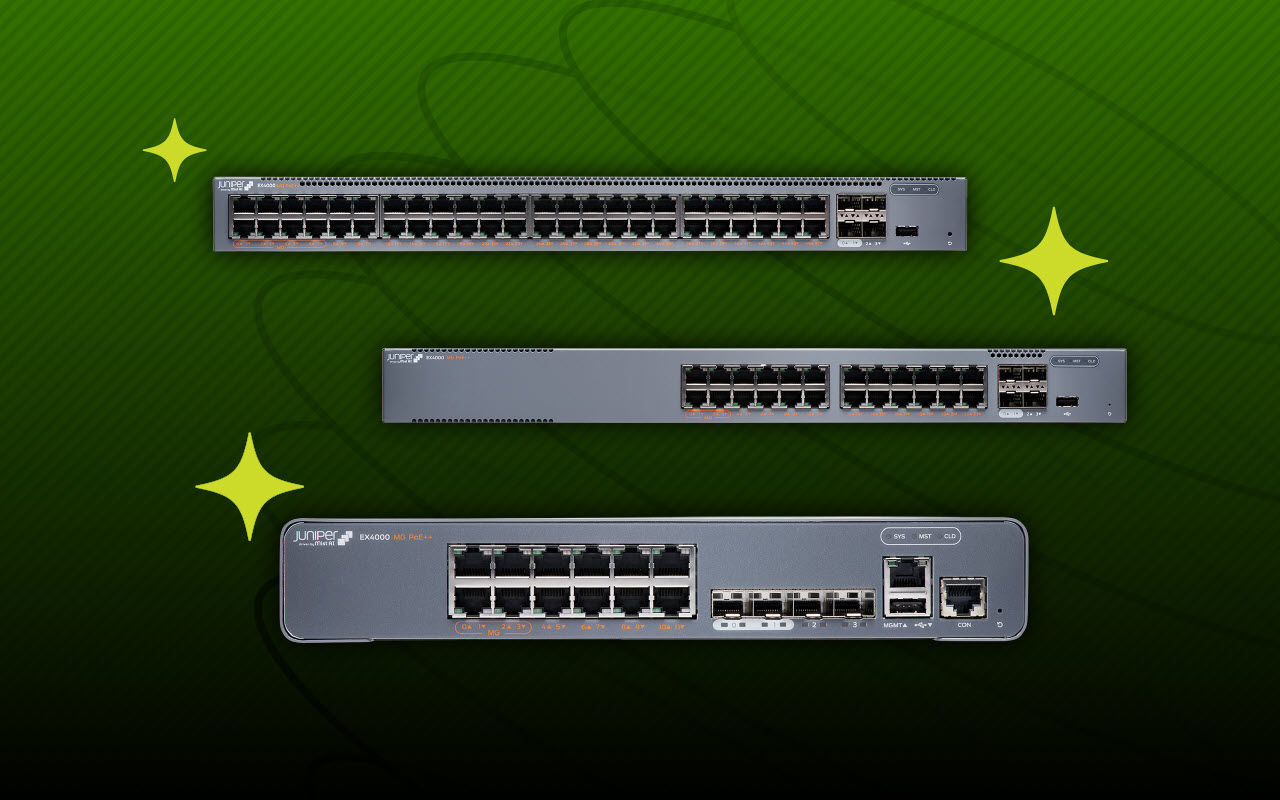Apstra Data Center Director Datasheet
Download DatasheetProduct Overview
Apstra Data Center Director, a turnkey, multivendor automation solution, allows customers to design, build, deploy, operate, and assure data center networks, simplifying and automating data center operations.
Data Center Director provides:
— A foundation for actionable insights with advanced network and application layer visibility, analytics, and customization
— Automation built for speed, reducing both deployment time and Day 2 configuration tasks
— Better network reliability by automatically generating correct vendor-specific configurations, pre-validating changes, and continuously validating network state
Product Description
Digital and artificial intelligence (AI) transformation is underway everywhere, and data center traffic has increased at a rapid pace. To ensure business success, you need to adapt quickly to the changes coming all around you. To achieve that, Apstra Data Center Director transforms your data center network operations by providing insights, speed, and reliability.
Insights
Apstra Data Center Director is the foundation for insights that drive exceptional user experiences. Comprehensive telemetry ensures that every relevant data point is collected and analyzed. Advanced analytics combine out-of-the-box network visibility with intuitive tools for customization. Flow Insights adds application layer visibility and analytics. These capabilities provide deep insights on their own, and a rich data foundation for the AI-driven insights provided by Juniper Data Center Assurance.
Speed
Data Center Director incorporates automation that covers the full lifecycle, from Day 0 planning through Day 2 operations—and it accelerates every phase.
Day 0 design tools enable customers to build a complete data center in software that is immediately ready for service as soon as switching hardware is deployed, reducing the time to service from weeks to just hours. In fact, because Data Center Director’s blueprints are completely vendor-independent, you can design your entire data center before you even choose a switching vendor, and then select the vendor that best fits your priorities, whether that’s price, delivery time, or other factors.
Day 2 provisioning is also far faster, enabling dramatic reductions in service provisioning time—some customers report as much as 20x faster—freeing you from laborious configuration tasks and allowing you to focus on delivering services that satisfy business needs.
Reliability
Data Center Director effectively eliminates most sources of human error, such as mistyped CLI commands, outdated automation scripts, and undocumented configuration changes, resulting in higher network and application availability. Only Data Center Director is vendor-independent and intent-based, so you never have to configure switches directly. The system automatically generates correct, vendor-specific configurations based on your intent, pre-validates every change with dozens of validity checks, and performs continuous intent validation so you know that the running network state matches your intent and you can detect and prevent problems before they impact applications and user experience. Juniper Validated Designs (JVDs) and repeatable blueprints also help to maintain consistency, improve reliability, and boost deployment speed.
These reliability features are critical to achieving the speed advantages discussed above. If you can’t trust your automation platform to deliver fully validated configurations and eliminate errors, you can’t deliver new services quickly with confidence. With Data Center Director, many customers find that they have the confidence to make service changes both rapidly and reliably, so they no longer need to schedule maintenance windows and wait to deliver the services their business needed, regulatory compliance, capacity planning, and cost control.
Features and Benefits
Apstra Data Center Director offers the following features:
Intent-based network design and operations
Intent-based data center automation increases application availability and reliability, simplifies deployment and operations, and dramatically reduces costs for enterprises, cloud service providers, and telco data centers. As the only intent-based networking technology to be hardware- and device OS-vendor agnostic, Data Center Director delivers on the vision of complete end-to-end data center automation, integrating capabilities such as group-based policies, enterprise scale, and significant intent-based analytics enhancements.
Lifecycle Management for Data Center Networks
Typically, architects design the network and operators manage it, resulting in a breakdown in information sharing and the absence of a single source of truth (SSOT). Architects are not aware of changes made to the network and operators are not fully informed of the capabilities and known limits of the system. Data Center Director eliminates these issues by creating an SSOT in a graph database and tracking all network moves, additions, and changes. Not only does Data Center Director track changes made to the network by other systems, but it also provides simple workflows for implementing changes across the entire network.
Advanced Telemetry: Intent-Based Analytics
For Day 2 operations, continuously monitoring and validating the operational state of your network infrastructure is critical to ensure that your intent is met, services are delivered as expected, and your network is healthy. Collecting telemetry data is necessary to achieve these goals, but not sufficient. Network operators frequently find themselves drowning in data collected by traditional monitoring systems because they don’t have the tools to analyze the data and extract actionable insights.
Data Center Director's intent‑based analytics (IBA) let you define the way you want to monitor and analyze telemetry data from your network. IBA enables you to create expert‑level rules and systems checks and embed them into the network management system so that they run continuously and update automatically as the network changes.
With IBA, you can create user‑defined, real‑time analytics pipelines using any of the built‑in processing functions, allowing you to codify the most complex troubleshooting scenarios and automate the extraction of insights from raw telemetry data.
Data Center Director ships with a variety of predefined IBA probes leveraging built‑in telemetry collectors. For Juniper devices, you can also create custom collectors from any “show” command, enabling you to collect any data that is available from those devices and then leverage IBA processing functions to apply custom analytics to the data and present the results in custom dashboards.
While IBA probes provide you with powerful, real‑time analytics, you can also gain insight into historical data through analytics reports. These reports leverage statistical analysis to help you understand the distribution of your data set over time, identify outliers, and analyze trends.
Scalability in Small and Large Data Centers
Data Center Director was designed to handle the largest data centers in the world, supporting hundreds of thousands of connected servers. This is achieved through support for 3‑stage or 5‑stage Clos IP fabrics with EVPN‑Virtual Extensible LAN (VXLAN) deployed as the overlay.
Data Center Director also supports smaller fabric designs. In edge data centers, for example, only a couple of switches may be deployed, but the number of deployments is large and highly distributed. Data Center Director can easily consolidate operations across edge data centers into a single management interface.
Regardless of the number and scale of deployments, the focus is on operator intent and translating that intent to configurations. Operators can easily make changes to these roles, driving large‑scale changes to configurations across multiple vendors and network designs. Data Center Director is built with a high‑throughput, highly‑scalable graph datastore that tracks all changes in real time, relieving the organization from having to manage individual IP addresses or configurations. This allows operators to focus on business‑specific needs rather than low‑level troubleshooting or reconfiguring of the network management system following every network change.
Flexible Fabric Design and Connectivity
Data Center Director solves the deployment and operational complexity of next‑generation data center networks by providing easy‑to‑deploy and highly‑validated fabric reference designs that can be used for any network size and cover multiple use cases. These designs are versatile with the support of enterprise and private cloud requirements through the leaf-spine Clos architecture, available in both 3-stage and 5-stage design variants. Additionally, AI training cluster use cases are supported with rail-optimized Clos architectures. In those designs, the fabric topology is optimized for intensive GPU traffic where GPU-to-GPU communication happens through rails, minimizing hops for higher performance and ensuring Ethernet lossless service for reliable RDMA traffic forwarding. For these specific applications, an AI template designer simplifies the process of creating validated, rail-aware design templates with minimal input, focusing on your server specifications. However, some data centers may require specific or bespoke topologies, protocols, or architectures that are not addressed by these templates.
Data Center Director’s “freeform” reference design allows you to build the design you want, how you want it. You can leverage any feature, protocol, or architecture that fits your deployment scenario. Freeform presents an interactive canvas to visually design or model any arbitrary network topology. The configuration is administered via configuration templates that grant you complete control over the configuration on the devices.
You can still leverage the same simple and powerful lifecycle management features, including device operating system upgrades, simple device deployments, pre‑deployment data center modeling, device telemetry, analytics dashboards, powerful intent‑based analytics, and Time Voyager.
Data Center Director also offers flexible connectivity options for servers, firewalls, and external routers. These connectivity options can be quickly attached to any port in the fabric with deterministic configuration to ensure that all protocols are properly functioning.
Time Voyager
A key operational feature for any network operator is rapidly recovering from human error. This is typically a complex, vendor‑specific process that requires a complete understanding of the full state of all boxes and their relationships with each other at certain points in time. The Time Voyager feature speeds up time to resolution by enabling the operator to move the entire state of the network (intent, configuration, and continuous validations) backward or forward with a few simple clicks, returning it to a specific point in time. This unique ability is enabled by its foundational intent‑based approach, including its SSOT graph database and assurance validations.
Data Center Interconnect
As networks expand and applications require greater geographic diversity of data centers, several vendors have introduced proprietary data center interconnect (DCI) features to address stretched Layer 2 domains and active/active topologies between data centers. By contrast, Data Center Director supports an industry‑standard EVPN‑VXLAN overlay that extends Layer 2 application segments outside of the Data Center Director‑managed topology. This allows architects to integrate multiple disparate computing centers for effective load balancing, legacy migration, disaster recovery, or resource sharing while isolating failure domains for high availability and resilience. Data Center Director automates the configuration of DCI with VXLAN tunnel stitching, dramatically reducing the complexity of unifying multiple data centers.
Access List Policies Assurance
The Data Center Director security policy provides a simple user interface and API that allows users to define policies to control the flow of traffic between virtual networks, IP endpoints, and routing zones. The policy is automatically applied as an L3 ACL on the relevant enforcement points, radically simplifying the management and reducing the size of access control lists. Furthermore, Data Center Director can detect conflicts when multiple policies are applied within a blueprint overlap and automatically resolve the conflicts based on user settings such as “more specific first” or “more generic first.” Users can search existing policies based on source/destination object and by type of traffic (protocol and port number) to determine if a certain traffic flow is affected by any active policies.
Support for All Modern Network Platforms
Data Center Director offers the industry’s first and only vendor‑agnostic, intent‑based networking platform, allowing enterprises to design a network without consideration for the hardware platforms that will eventually be deployed. The tools used to design and manage the network are the same, regardless of which vendor hardware or network operating system is ultimately selected. This translates to massive reductions in OpEx by eliminating the need to maintain staff expertise in multiple platforms and vendor nuances. There is also an opportunity to reduce CapEx by allowing all modern vendors to be considered for
Flow Data
Flow Insights, a multivendor network observability solution for modern data centers, delivers unprecedented insights at any scale for network performance, availability, and security. Flow Insights provides complete network visibility and in‑depth analysis of traffic patterns so administrators can pinpoint the cause of a problem and resolve the issues. Having this extensive visibility optimizes network performance, enhances security, and improves capacity planning and cost control.
Flow Insights provides granular information about network traffic flows, including source and destination IP addresses, ports, protocols, and the amount of data transmitted. When network administrators have this information, they can better understand the network's performance and identify potential issues, such as congestion, high latency, or packet loss.
Network engineers can leverage the insights from Flow Insights to implement strategies that optimize network traffic flow, reducing latency, balancing loads across network paths, and ensuring the most efficient use of available resources.
Flow Insights’ ability to enrich multivendor network traffic with organization‑specific information enables more in‑depth analysis and a better understanding of network traffic patterns, resource usage, and security risks. Flow Insights helps organizations improve their security posture, detect and respond to threats more effectively, and maintain compliance with regulatory requirements.
VMware Integrations
Data Center Director tightly integrates with VMware NSX‑T and VMware vCenter to provide network operators visibility into virtual workloads and networks. The built‑in validation speeds up the troubleshooting of virtual networking, port‑group/fabric VLAN/Link Aggregation Control Protocol (LACP) mismatch, and VM traffic issues. Remediation workflows help users resolve misconfiguration of VLANs faster by automatically suggesting the correct network fabric changes.
Juniper Data Center Assurance
Juniper Data Center Assurance is a suite of cloud-based AIOps applications, powered by Mist™, Juniper’s AI-native networking platform, that complement the on-premises Apstra Data Center Director. It delivers AI-driven insights that enable network operators to dramatically reduce troubleshooting time and move from reactive to proactive assurance of both data center networks and applications. Data Center Assurance provides functions such as Predictive Assurance; Application Awareness with visibility, troubleshooting, and impact analysis; Service Level Expectations; and the Marvis® AI Assistant for Data Center.
| Feature | Standard | Advanced | Premium | Connector for VMware |
| Network design | ||||
| 3-stage and 5-stage Clos design | X | X | X | |
| Collapsed fabric design (edge data centers) | X | X | X | |
| Rail-Optimized Clos Design (AI training data centers) | X | |||
| Rail-Collapsed Clos Design (AI training data centers) | X | |||
| L2 access switches | X | X | X | |
| High availability switches at the access layer | X | X | X | |
| Freeform design (any network design) | X | X | X | |
| IPv4 fabric (non-EVPN) | X | X | X | |
| IPv6 fabric RFC-5549 (non-EVPN) | X | X | X | |
| EVPN fabric | X | X | X | |
| Virtual routing and forwarding tables (VRFs) | X | X | X | |
| L2/L3 virtual networks (IPv4/IPv6) | X | X | X | |
| Intra-rack (VLAN), or inter-rack (VXLAN) virtual networks | X | X | X | |
| Single or dual homing of external systems (MLAG/vPC/ESI) | X | X | X | |
| L3 sub-interfaces | X | X | X | |
| Dynamic Host Configuration Protocol (DHCP) relay | X | X | X | |
| External BGP peering | X | X | X | |
| Dynamic BGP neighbors | X | X | X | |
| Granular import/export routing policies | X | X | X | |
| Static routes | X | X | X | |
| Remote EVPN gateways for L2/L3 Data Center Interconnect (DCI) | X | X | ||
| Integrated Interconnect/VXLAN Stitching (DCI) | X | X | ||
| Mixed vendor fabrics (i.e. fabrics with non-Juniper devices) | X | |||
| Device OS | ||||
| Junos® operating system and vJunos-switch | X | X | X | |
| Junos OS Evolved and vJunosEvolved | X | X | X | |
| Cisco NX-OS and NX-OSv | X | |||
| Arista EOS and vEOS | X | |||
| Enterprise and Edge Standard SONiC® | X | |||
| Server OS | ||||
| Ubuntu 22.04 (On NVDIA DGX series) | X | |||
| Telemetry services | ||||
| Address Resolution Protocol (ARP) table | X | X | X | |
| Media access control (MAC) table | X | X | X | |
| BGP session | X | X | X | |
| Hostname | X | X | X | |
| Interface and interface counters | X | X | X | |
| Interface queue counters (Ex: ECN, PFC) and buffer utilization | X | |||
| GPU Based RoCE v2 Traffic Counters (Ex: CNP, OOS) | X | |||
| Transceiver information and diagnostics | X | X | X | |
| Link Aggregation Group/Multichassis Link Aggregation Group (LAG/MLAG) information | X | X | X | |
| Link Layer Discovery Protocol (LLDP) information | X | X | X | |
| Resource utilization (disk, memory, CPU) | X | X | X | |
| Device environmental health (power supply, fan temperature, etc.) | X | X | ||
| Telemetry services health | X | X | X | |
| Custom telemetry collector (any additional telemetry) | X | X | ||
| IP route table | X | X | X | |
| Active configuration | X | X | X | |
| EVPN flooding table | X | X | ||
| EVPN routing table | X | X | ||
| Flow data (sFlow, NetFlow, IPFIX, and IFA) | X | |||
| Intent‑based analytics (IBA) | ||||
| Custom dashboards and widgets | X | X | X | |
| Programmable probes | X | X | X | |
| Tags and property sets for custom probes | X | X | X | |
| Device system health and environmental checks | X | X | X | |
| Device traffic and headroom | X | X | X | |
| LAG imbalance | X | X | X | |
| MLAG imbalance* | X | X | X | |
| ESI imbalance* | X | X | X | |
| Equal-cost multipath (ECMP) imbalance for fabric interfaces | X | X | X | |
| MAC monitoring | X | X | X | |
| Telemetry streaming via protocol buffers | X | X | ||
| Bandwidth utilization | X | X | ||
| Critical services: utilization, trending, alerting* | X | X | ||
| Leafs hosting critical services: utilization, trending, alerting* | X | X | ||
| Drain traffic anomaly | X | X | X | |
| Equal-cost multipath (ECMP) imbalance for spine to super spine interfaces* | X | X | ||
| Equal-cost multipath (ECMP) imbalance for external interfaces | X | X | ||
| Spine fault tolerance* | X | X | ||
| EVPN-VXLAN type-3 route validation* | X | X | ||
| EVPN-VXLAN type-5 route validation* | X | X | ||
| VXLAN flood list validation* | X | X | ||
| EVPN host flaps detection* | X | X | ||
| BGP monitoring | X | X | ||
| Hot/cold fabric ports | X | X | ||
| Hot/cold spine to super spine* | X | X | ||
| Hot/cold‑specific interfaces | X | X | ||
| Packet discard | X | X | ||
| Interface flapping | X | X | ||
| Total east-west traffic* | X | X | ||
| Optical transceivers | X | X | ||
| Display external routes* | X | X | ||
| Connectivity fault model* | X | X | ||
| Cabling fault model* | X | X | ||
| Multi-agent detector (Arista only)* | X | |||
| Hypervisor and fabric VLAN configuration mismatch* | X | |||
| VMs without fabric configured VLANs* | X | |||
| Hypervisor and fabric LAG configuration mismatch* | X | |||
| Hypervisor missing LLDP configuration* | X | |||
| Hypervisor maximum transmission unit (MTU) mismatch* | X | |||
| Hypervisor MTU check* | X | |||
| Hypervisor redundancy check* | X | |||
| Stripe and rail traffic* | X | |||
| Interface queue stats monitoring* | X | |||
| GPU hardware traffic monitoring* | X | |||
| Platform | ||||
| Apstra Data Center Director server backup/restore | X | X | X | |
| Apstra Data Center Director server health reporting | X | X | X | |
| Apstra Data Center Director server upgrades | X | X | X | |
| RESTful APIs | X | X | X | |
| API user guides and API Explorer | X | X | X | |
| Graph model and GraphQL/QE API | X | X | X | |
| Telegraf input plugin | X | X | ||
| Apstra Data Center Director CLI | X | X | X | |
| Apstra Data Center Director Developer SDK (Python) | X | X | X | |
| Extensible on-box or off-box device agents | X | X | X | |
| Multiuser administration | X | X | X | |
| Role-based access control | X | X | X | |
| Self-integrity check | X | X | X | |
| Security | ||||
| Multiuser administration | X | X | X | |
| Role-based access control | X | X | X | |
| LDAP authentication | X | X | X | |
| TACACS+ authentication | X | X | X | |
| RADIUS authentication | X | X | X | |
| Active Directory authentication | X | X | X | |
| HTTPS UI | X | X | X | |
| Apstra Data Center Director server security hardening | X | X | X | |
| API-driven operation | X | X | X | |
| Template types and options | X | X | X | |
| Connectivity templates | X | X | X | |
| Configlets with granular scope (e.g., interface level) | X | X | X | |
| Config templates (Freeform only) | X | X | X | |
| Property sets | X | X | X | |
| Tags management | X | X | X | |
| Resource pool management | X | X | X | |
| Day 2 rack modifications | X | X | X | |
| Day 2 fabric extension | X | X | X | |
| Advanced load balancing (dynamic load balancing & global load balancing) | X | |||
| Day 2+ operations | ||||
| Staged/commit workflows | X | X | X | |
| Rollback network state (Time Voyager) | X | X | X | |
| Add/remove generic systems | X | X | X | |
| Add/update/remove racks | X | X | X | |
| Add/remove pods | X | X | X | |
| Network OS upgrade/downgrade | X | X | X | |
| Change/add interface | X | X | X | |
| Turning interface up/down | X | X | X | |
| Break/form lags | X | X | X | |
| Device maintenance | X | X | X | |
| Device decommissioning | X | X | X | |
| Device replacement | X | X | X | |
| Resource utilization | X | X | X | |
| Virtual network management with bulk operations | X | X | X | |
| Automatic Virtual Network and Connectivity Template creation and assignment for Rail-Optimized fabrics | X | |||
| Marvis AI Assistant for Data Center | X | X | X | |
| Application Awareness | X | |||
| Impact Analysis | X | |||
| Predictive Assurance | X | |||
| Service Level Expectations dashboards | X | |||
| Policy assurance | ||||
| Configuration drift detection | X | X | X | |
| Routing zone constraint policies | X | X | X | |
| Access list policies—conflict detection and resolution | X | |||
| 802.1x network admission control | X | |||
| Traffic control with ACLs | X | |||
| Policies management | X | |||
| Cabling map: anti-affinity policies | X | |||
| Security policy (firewall filters/access control lists) | X | |||
| Device management | ||||
| Universal Zero Touch Provisioning (ZTP) with graphical user interface | X | X | X | |
| Device agent installer | X | X | X | |
| Lifecycle management | X | X | X | |
| Device quarantine | X | X | X | |
| Device maintenance | X | X | X | |
| Virtual infrastructure integration | ||||
| VMware vCenter | X | |||
| VMware NSX-T | X | |||
Ordering Information
Please contact your Juniper sales representative for information on ordering Apstra Data Center Director.
About Juniper Networks
Juniper Networks believes that connectivity is not the same as experiencing a great connection. Mist™, Juniper's AI-native networking platform, is built from the ground up to leverage AI to deliver exceptional, highly secure, and sustainable user experiences from the edge to the data center and cloud. Additional information can be found at juniper.net or connect with Juniper on X (formerly Twitter), LinkedIn, and Facebook.
1000699 - 014 - EN JUNE 2025






















